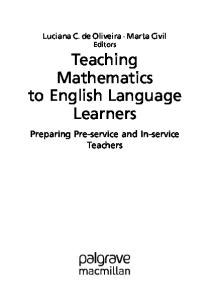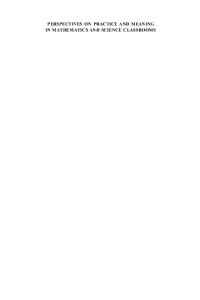Teaching Mathematics in Multilingual Classrooms
Increasingly, teachers all over the world are grappling on a daily basis with the fact of multilingual classrooms. In this book, Jill Adler captures three inter-related dilemmas that lie at the heart of teaching mathematics in multilingual classrooms. Adl
- PDF / 1,569,307 Bytes
- 187 Pages / 504 x 648 pts Page_size
- 35 Downloads / 386 Views
Mathematics Education Library VOLUME 26
Managing Editor A.J. Bishop, Monash University, Melbourne, Australia
Editorial Board H. Bauersfeld, Bielefeld, Germany J.P. Becker, Illinois, U.S.A. G. Leder, Melbourne, Australia A. Sfard, Haifa, Israel O. Skovsmose, Aalborg, Denmark S. Turnau, Krakow, Poland
The titles published in this series are listed at the end of this volume.
TEACHING MATHEMATICS IN MULTILINGUAL CLASSROOMS
by
JILL ADLER Department of Mathematics, University of the Witwatersrand, Johannesburg, South Africa
KLUWER ACADEMIC PUBLISHERS NEW YORK /BOSTON /DORDRECHT/LONDON/MOSCOW
eBook ISBN: Print ISBN:
0-306-47229-5 0-792-37079-1
©2002 Kluwer Academic Publishers New York, Boston, Dordrecht, London, Moscow
All rights reserved
No part of this eBook may be reproduced or transmitted in any form or by any means, electronic, mechanical, recording, or otherwise, without written consent from the Publisher
Created in the United States of America
Visit Kluwer Online at: and Kluwer's eBookstore at:
http://www.kluweronline.com http://www.ebooks.kluweronline.com
To Taffy
TABLE OF CONTENTS FOREWORD BY DAVID PIMM
xi
ACKNOWLEDGEMENTS
xv
A NOTE ON TERMINOLOGY
xvi
CHAPTER 1 / The Elusive Dynamics of TeachingMathematics in Multilingual Classrooms 1. Introduction 2. Sketching the Dilemmas 3. A Journey into Theory, Research and Practice 4. Overview of the Book 5. Concluding Reflections
1 1 2 5 14 15
CHAPTER 2 / Complexity andDiversity: The Language andMathematics Education Terrain in South Africa 1. Introduction 2. Dealing with Apartheid’s Legacy 3. Changing Language-in-Education Policy and Practice 4. English Language Infrastructure across South African Schools 5. Language-in-Use in Day-to-Day Activity 6. Curriculum Policy, Mathematics and Language 7. In Conclusion CHAPTER 3 / Accessing Teachers’ Tacit and Articulated Knowledge 1. Teachers’ Knowledge - The Departure Point 2. A Sociocultural Perspective on Teachers’ Knowledgeability 3. Design: Issues in Teacher Selection, Data Sources and Analysis 4. The Noisy, Yet Often Silenced Issues 5. In Conclusion CHAPTER 4 / Dilemmas in Teaching: A Prelude and Frame 1. Introduction 2. Managing Dilemmas: A Practical Account of Teachers’ Actions 3. Dilemmas in Teaching: A Dialectic Account of Teachers’ Actions 4. Dilemmas in Teaching: A Context for Knowledge Growth in Teaching 5. A Language of Dilemmas: A Framework with which to Proceed
17 17 18 23 27 31 31 34 35 35 36 37 41 48 49 49 49 51 54 55
VIII
TABLE OF CONTENTS
CHAPTER 5 / Teachers Talking about Teaching: The Emergence of Dilemmas 1. Introduction 2. A First Level of Analysis 3. Commonalities 4. Divergences and the Emergence of Dilemmas 5. Producing the Dilemmas 6. In Conclusion
57 57 57 59 61 67 70
CHAPTER 6 / Language(s) as Resource and the Dilemma of Code-Switching 1. Introduction 2. Code-switching in Bi-/Multilingual Mathematics Classrooms 4. The Dilemma of Code-switching: Action in and Reflection on Thandi’s Classroom Practice 4. Dilemmas of Code-switching across Contexts 5. The Dilemma of Cod
Data Loading...











